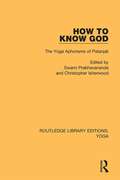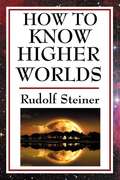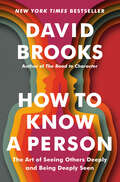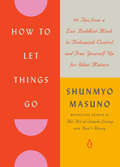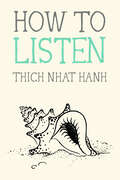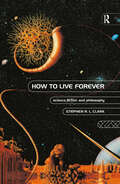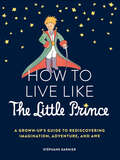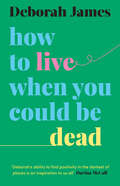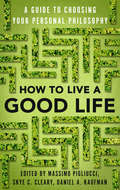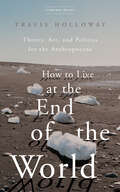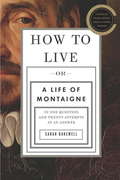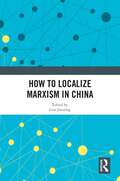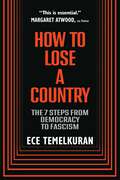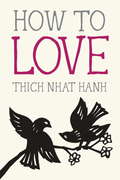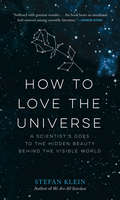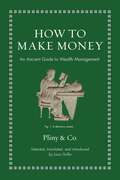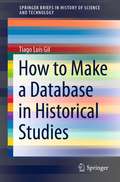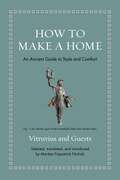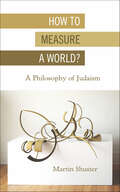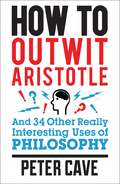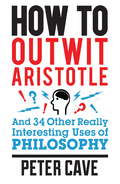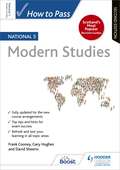- Table View
- List View
How to Know God: The Yoga Aphorisms of Patanjali (Routledge Library Editions: Yoga #2)
by Swami Prabhavananda Christopher IsherwoodThe aphorisms collected in this book, first published in 1953, were composed by Patanjali, a great Indian sage, over 1,500 years ago, and here translated into clear English prose. The accompanying commentary interprets the sayings for the modern world, and in doing so gives a full picture of what yoga is, what its aims are, and how it can be practised.
How to Know Higher Worlds
by Rudolf SteinerThere slumber in every human being faculties by means of which she can acquire for herself a knowledge of higher worlds. Mystics, Gnostics, Theosophists - all speak of a world of soul and spirit which for them is just as real as the world we see with our physical eyes and touch with our physical hands. At every moment the listener may say to herself: that, of which they speak, I too can learn, if I develop within myself certain powers which today still slumber within me. There remains only one question - how to set to work to develop such faculties.
How to Know a Person: The Art of Seeing Others Deeply and Being Deeply Seen
by David BrooksNEW YORK TIMES BESTSELLER • A practical, heartfelt guide to the art of truly knowing another person and fostering deeper connections at home, at work, and throughout our lives—from the author of The Road to Character and The Second Mountain&“More than a guide to better conversations, it&’s a blueprint for a more connected and humane way of living. It&’s a must-read for anyone looking to deepen their relationships and broaden their perspectives.&”—Bill Gates, GatesNotes (Summer Reading Pick)As David Brooks observes, &“There is one skill that lies at the heart of any healthy person, family, school, community organization, or society: the ability to see someone else deeply and make them feel seen—to accurately know another person, to let them feel valued, heard, and understood.&”And yet all around are people who feel invisible, unseen, misunderstood. In How to Know a Person, Brooks sets out to help us do better, posing essential questions: If you want to know a person, what kind of attention should you cast on them? What kind of conversations should you have? What parts of a person&’s story should you pay attention to?Driven by his trademark sense of curiosity and determination to grow as a person, Brooks draws from the fields of psychology and neuroscience and the worlds of theater, philosophy, history, and education to present a welcoming, hopeful, integrated approach to human connection. How to Know a Person helps readers become more understanding and considerate toward others, and to find the joy that comes from being seen. Along the way it offers a possible remedy for a society that is riven by fragmentation, hostility, and misperception.The act of seeing another person, Brooks argues, is profoundly creative: How can we look somebody in the eye and see something large in them and, in turn, see something larger in ourselves? How to Know a Person is for anyone searching for connection, and yearning to be understood.
How to Let Things Go: 99 Tips from a Zen Buddhist Monk to Relinquish Control and Free Yourself Up for What Matters
by Shunmyo MasunoFeeling overwhelmed? Step away from life's demands and free yourself up for what matters with this succinct and sensible guide by the Zen Buddhist author of the international bestsellers The Art of Simple Living and Don't Worry.Amid the relentless cycle of news, social media, emails, and texts, it can be hard to know when, if ever, you can take a break from everything clamoring for your attention. The internationally bestselling Buddhist monk Shunmyo Masuno offers a radical message: You can leave it all be, and, indeed, sometimes the best thing you can learn is how to do nothing. How to Let Things Go will teach you to:Lesson #2: Give people space—being caring and being nosy are not the same thing.Lesson #15: Remember that social media is a tool and nothing more.Lesson #19: Let a relationship come to an end rather than force it.Lesson #40: Think of letting things go not as throwing them away but as setting them free.Lesson #75: Make decisions in the light of the morning—don't rush into them.Lesson #90: Slow down and take more breaks.With these and ninety-three other practical tips, you can abandon the futile pursuit of trying to control everything and discover the key to a fulfilling social life; individual well-being; and a calmer, more focused mind.
How to Listen (Mindfulness Essentials #11)
by Thich Nhat HanhListening with compassion can solve our most pressing issues—across global politics and interpersonal relationships and within our own hearts and minds.In How to Listen, Zen Master Thich Nhat Hanh demonstrates how deep listening is a fundamental building block of good communication. But perhaps more fundamentally, listening is central to our practice, a basic ingredient to strengthen our capacity for mindfulness, concentration, insight, and compassion. Learning how to listen with equanimity to life itself, we generate insight into the true nature of our deep connection to all things. And from this place of understanding—when we know that we aren&’t separate—our capacity to listen deepens even further. With clear and gentle guidance from Thich Nhat Hanh, we learn how truly listening—to ourselves, to each other, to Mother Earth, and to the many &“bells of mindfulness&” that are available to us in each moment—is the foundation of our practice, an expression of love, and a solution to our deepest and most urgent large-scale conflicts. All Mindfulness Essentials books are illustrated with playful sumi-ink drawings by California artist Jason DeAntonis.
How to Live Forever: Science Fiction and Philosophy
by Stephen R ClarkImmortality is a subject which has long been explored and imagined by science fiction writers. In his intriguing new study, Stephen R.L.Clark argues that the genre of science fiction writing allows investigation of philosophical questions about immortality without the constraints of academic philosophy. He reveals how fantasy accounts of issues such as resurrection, disembodied survival, reincarnation and devices or drugs for preserving life can be used as an important resource for philosophical inquiry and examines how a society of immortals might function through a reading of the vampire myth. How to Live Forever is a compelling study which introduces students and professional philosophers to the possibilities of using science fiction in their work. It includes extensive suggestions for further reading, both fictional and philosophical, and examines the work of such major science fiction authors as Arthur C. Clarke, Frank Herbert, Larry Niven, William Gibson, and Colin Wilson.
How to Live Like the Little Prince: A Grown-Up's Guide to Rediscovering Imagination, Adventure, and Awe
by Stéphane Garnier"All grown-ups were once children... but only a few of them remember it."–Antoine St. Exupéry, The Little PrinceFull of insight, inspiration, and gentle compassion for our complicated modern lives, How to Live Like the Little Prince captures the brilliance and wisdom of Antoine St. Exupéry's beloved tale. Through the eyes of the iconic Little Prince, Stéphane Garnier reminds us who we were before we grew up and teaches us to once again take time to live, play, and find wonder in the small, everyday moments.Few books have been as universally cherished as Antione St. Exupéry's The Little Prince. First published in 1943 and now one of the bestselling books of all time, the haunting, lyrical fable explores the meaning of life through a young boy who travels the universe in search of happiness.In How to Live Like the Little Prince, Stéphane Garnier revisits St. Exupér's story with a fresh, contemporary eye, urging us—as the Little Prince did—to preserve our childlike wonder by slowing down, dreaming big, and showing humble kindness to our planet and one another. In each chapter, Garnier beautifully conjures the expressive wisdom of St. Exupéry's storytelling, reminding us of essential lessons like how to be rebellious and incorruptible, how to leave your mark on the world, how to be free from the judgment of others, and how to let go and be alone.Featuring the iconic original illustrations from The Little Prince alongside memorable quotations and thought-provoking ideas about how we can apply St. Exupéry's philosophies to the increasingly complex demands of modern life, Garnier offers a stirring guide to rediscovering what matters most—at any age.A great gift for fans of The Little Prince, graduation, retirement, and other life milestones.
How to Live When You Could Be Dead
by Deborah James"Deborah James has captured the heart of the nation." —The Duke and Duchess of Cambridge @KensingtonRoyal"Brave, bright, beautiful." —Lorraine Kelly"Deborah's ability to find positivity in the darkest of places is an inspiration to us all." —Davina McCall"I was alive when I should have been dead. In another movie, I missed the sliding door and departed this wondrous life long ago. Like so many others, I had to learn to live not knowing if I have a tomorrow, because, statistically, I didn't. At the age of 35, I was blindsided by incurable bowel cancer—I was given less than an 8 percent chance of surviving five years. Five years later, my only option was to live in the now and to value one day at a time."How do you turn your mind from a negative spiral into realistic and rebellious hope? How do you stop focusing on the why and realize that "why not me" is just as valid a question?When Deborah James was diagnosed with incurable bowel cancer at just 35, she learned a powerful lesson: the way we respond to any given situation empowers or destroys us. And with the right skills and approach, we can all face huge challenges and find strength and hope in the darkest of places.How to Live When You Could Be Dead, a Sunday Times bestseller, will show you how. It will awaken you to question your life as if you didn't have a tomorrow and live it in the way you want to today. By harnessing the power of positivity and valuing each day as though it could be your last, you'll find out, as Deborah did, that it is possible to live with joy and purpose, no matter what.
How to Live a Good Life: A Guide to Choosing Your Personal Philosophy
by Massimo Pigliucci Skye Cleary Daniel KaufmanA collection of essays by fifteen philosophers presenting a thoughtful, introductory guide to choosing a philosophy for living an examined and meaningful life. A VINTAGE ORIGINALSocrates famously said "the unexamined life is not worth living," but what does it mean to truly live philosophically?This thought-provoking, wide-ranging collection brings together essays by fifteen leading philosophers reflecting on what it means to live according to a philosophy of life. From Eastern philosophies (Daoism, Confucianism, and Buddhism) and classical Western philosophies (such as Aristotelianism and Stoicism), to the four major religions, as well as contemporary philosophies (such as existentialism and effective altruism), each contributor offers a lively, personal account of how they find meaning in the practice of their chosen philosophical tradition.Together, the pieces in How to Live a Good Life provide not only a beginner's guide to choosing a life philosophy but also a timely portrait of what it means to live an examined life in the twenty-first century.
How to Live at the End of the World: Theory, Art, and Politics for the Anthropocene
by Travis HollowayAssessing the dawn of the Anthropocene era, a poet and philosopher asks: How do we live at the end of the world? The end of the Holocene era is marked not just by melting glaciers or epic droughts, but by the near universal disappearance of shared social enterprise: the ruling class builds walls and lunar shuttles, while the rest of us contend with the atrophy of institutional integrity and the utter abdication of providing even minimal shelter from looming disaster. The irony of the Anthropocene era is that, in a neoliberal culture of the self, it is forcing us to consider ourselves as a collective again. For those of us who are not wealthy enough to start a colony on Mars or isolate ourselves from the world, the Anthropocene ends the fantasy of sheer individualism and worldlessness once and for all. It introduces a profound sense of time and events after the so-called "end of history" and an entirely new approach to solidarity. How to Live at the End of the World is a hopeful exploration of how we might inherit the name "Anthropocene," renarrate it, and revise our way of life or thought in view of it. A book on time, art, and politics in an era of escalating climate change, Holloway takes up difficult, unanswered questions in recent work by Donna Haraway, Kathryn Yusoff, Bruno Latour, Dipesh Chakrabarty, and Isabelle Stengers, sketching a path toward a radical form of democracy – a zoocracy, or, a rule of all of the living.
How to Live: Or A Life of Montaigne in One Question and Twenty Attempts at an Answer
by Sarah BakewellWinner of the 2010 National Book Critics Circle Award for Biography How to get along with people, how to deal with violence, how to adjust to losing someone you love--such questions arise in most people's lives. They are all versions of a bigger question: how do you live? How do you do the good or honorable thing, while flourishing and feeling happy?This question obsessed Renaissance writers, none more than Michel Eyquem de Monatigne, perhaps the first truly modern individual. A nobleman, public official and wine-grower, he wrote free-roaming explorations of his thought and experience, unlike anything written before. He called them "essays," meaning "attempts" or "tries." Into them, he put whatever was in his head: his tastes in wine and food, his childhood memories, the way his dog's ears twitched when it was dreaming, as well as the appalling events of the religious civil wars raging around him. The Essays was an instant bestseller and, over four hundred years later, Montaigne's honesty and charm still draw people to him. Readers come in search of companionship, wisdom and entertainment--and in search of themselves.This book, a spirited and singular biography, relates the story of his life by way of the questions he posed and the answers he explored. It traces his bizarre upbringing, youthful career and sexual adventures, his travels, and his friendships with the scholar and poet Étienne de La Boétie and with his adopted "daughter," Marie de Gournay. And we also meet his readers--who for centuries have found in Montaigne an inexhaustible source of answers to the haunting question, "how to live?"
How to Localize Marxism in China
by Guo JianningThis book explores frontier issues concerning the localization of Marxism in China by examining historical processes, cultural implications, and contemporary perspectives on this process of indigenization. Emerging in the 1840s in Germany, Marxism has evolved from a German, European, and Western idea into a Chinese, Asian, and Eastern one. This title seeks to answer the question of how Marxism has been adapted to the Chinese context and how it migrated the regions. The first three chapters chart the history of the dissemination of Marxism to adapt to Chinese conditions across three periods – revolutionary times before 1949, the period of socialist construction after 1949, and the reform and opening-up since 1978. The subsequent two chapters analyze the experience of the development of socialism with Chinese characteristics, featuring synergistic integration with traditional Chinese culture and the combining of the basic principles of Marxism and China's real-life situation. The final chapter advances suggestions on how to further promote the localization of Marxism and how to develop contemporary Chinese Marxism, faced with new historical conditions. The book will appeal to scholars, students, and general readers interested in contemporary Marxism, Marxism in China, and contemporary Chinese history, politics, and society.
How to Lose Yourself: An Ancient Guide to Letting Go (Ancient Wisdom for Modern Readers)
by Jay L. Garfield, Maria Heim, and Robert H. SharfInviting new translations of classical Buddhist texts about why the self is an illusion—and why giving it up can free us from sufferingFrom self-realization and self-promotion to self-help and the selfie, the modern world encourages us to be self-obsessed. We are even told that finding ourselves is the key to happiness. Better to lose yourself! More than 2,500 years ago, the Buddha argued that the self is an illusion—and that our belief in it is the cause of most, if not all, of our suffering. How to Lose Yourself presents lively, accessible, and expert new translations of ancient Buddhist writings about the central, unique, and powerful Buddhist teaching of &“no-self.&”Drawn from three important Buddhist traditions, these essential Indian, Tibetan, and Chinese writings provide a rich sampling of the ways Buddhist philosophers have understood the idea that we are selfless persons—and why this insight is so therapeutic. When we let go of the self, we are awakened to the presence of all things as they truly are, and we let go of the anxiety, fear, greed, and hatred that are the source of all suffering.Complete with an introduction and headnotes to each selection, and the original texts on facing pages, How to Lose Yourself is a concise guide to a transformative idea.
How to Lose a Country: The 7 Steps from Democracy to Fascism
by Ece Temelkuran&“Essential.&” —Margaret Atwood An urgent call to action and a field guide to spotting the insidious patterns and mechanisms of the populist wave sweeping the globe from an award-winning journalist and acclaimed political thinker.How to Lose a Country is a warning to the world that populism and nationalism don&’t march fully-formed into government; they creep. Award-winning author and journalist Ece Temelkuran identifies the early warning signs of this phenomenon, sprouting up across the world from Eastern Europe to South America, in order to arm the reader with the tools to recognise it and take action. Weaving memoir, history and clear-sighted argument, Temelkuran proposes alternative answers to the pressing—and too often paralysing—political questions of our time. How to Lose a Country is an exploration of the insidious ideas at the core of these movements and an urgent, eloquent defence of democracy. This 2024 edition includes a new foreword by the author.
How to Love
by Thich Nhat Hanh Jason DeantonisHow to Love is the third title in Parallax's Mindfulness Essentials Series of how-to titles by Zen Master Thich Nhat Hanh, introducing beginners and reminding seasoned practitioners of the essentials of mindfulness practice. <P> This time Nhat Hanh brings his signature clarity, compassion, and humor to the thorny question of how to love. He distills one of our strongest emotions down to four essentials: you can only love another when you feel true love for yourself; love is understanding; understanding brings compassion; deep listening and loving speech are key ways of showing our love. Pocket-sized, with original two color illustrations by Jason DeAntonis, How to Love shows that when we feel closer to our loved ones, we are also more connected to the world as a whole. With sections on Love vs. Need, Being in Love, Reverence, Intimacy, Children and Family, Reconciling with Parents, and more, How to Love includes meditations you can do alone or with your partner to go deep inside and expand your own capacity to love.Scientific studies indicate that meditation contributes tremendously to well-being, general health, and longevity. How to Love is a unique gift for those who want a comprehensive yet simple guide to understanding the many different kinds of love, along with meditative practices that can expand the understanding of and capacity for love, appropriate for those practicing in any spiritual tradition, whether seasoned practitioners or new to meditation.
How to Love the Universe: A Scientist's Odes to the Hidden Beauty Behind the Visible World
by Stefan KleinAn eye-opening celebration of the marvels of space, time, the cosmos, and moreHow to Love the Universe is a new kind of science writing by an author truly enamored of the world around him. In ten short chapters of lyrical prose—each one an ode to a breathtaking realm of discovery—Stefan Klein uses everyday objects and events as a springboard to meditate on the beauty of the underlying science. Klein sees in a single rose the sublime interdependence of all life; a day of stormy weather points to the world’s unpredictability; a marble conjures the birth of the cosmos. As he contemplates the deepest mysteries—the nature of reality, dark matter, humanity’s place among the galaxies, and more—Klein encourages us to fall in love with the universe the way scientists do: with a grasp of the key ideas and theories of twenty-first-century physics that bring to life the wonders of, really, everything. You won’t look at a rose—or at our world—the same way again.
How to Make Money: An Ancient Guide to Wealth Management (Ancient Wisdom For Modern Readers Ser.)
by Pliny Co.An enriching collection of classical writings about how ancient Romans made—and thought about—moneyAncient Romans liked money. But how did they make a living and sometimes even become rich? The Roman economy was dominated by agriculture, but it was surprisingly modern in many ways: the Romans had companies with CEOs, shareholders, and detailed contracts regulated by meticulous laws; systems of banking and taxation; and a wide range of occupations, from merchant and doctor to architect and teacher. The Romans also enjoyed a relatively open society, where some could start from the bottom, work, invest, and grow rich. How to Make Money gathers a wide variety of ancient writings that show how Romans thought about, made, invested, spent, lost, and gave away money.The Roman elite idealized farming and service to the state but treated many other occupations with suspicion or contempt, from money lending to wage labor. But whatever their attitudes, pecunia made the Roman world go round. In the Satyricon, Trimalchio brags about his wealth. Seneca accumulated a fortune—but taught that money can&’t buy happiness. Eumachia inherited a brick factory from her father, married well, and turned to philanthropy after she was widowed. How to Make Money also takes up some of the most troubling aspects of the Roman economy, slavery and prostitution, which the elite deemed unrespectable but often profited from.Featuring lively new translations, an illuminating introduction, and the original Latin and Greek texts on facing pages, How to Make Money offers a revealing look at the Roman worlds of work and money.
How to Make a Database in Historical Studies (SpringerBriefs in History of Science and Technology)
by Tiago Luís GilThis book is a greatly supplemented translation from Portuguese, originally published in 2015. It discusses the most appropriate ways to create databases for research on history and other humanities, including an extensive debate about the usages that historians have made of computing since the 1950s. It has four chapters: the first is dedicated to theoretical and methodical questions about the usage of databases in history; the second is about technical issues; the third presents the concept of research engineering (how to improve research in groups); the last is about the construction of databases. The author states that the use of technology in research in history and humanities should be preceded and mediated by theories and methods which deal with these disciplines and not by technical issues. The historian must know how to think “correctly” in order to use the technological tools in an autonomous way. The book provides a background, demonstrating how theory, methodology, and technique are always articulated in historical research, and will appeal to history students and researchers.
How to Make a Home: An Ancient Guide to Style and Comfort (Ancient Wisdom for Modern Readers)
by VitruviusAn entertaining and enlightening collection of ancient Roman writings about home design and decorationThe idea that our homes can communicate professional as well as personal identities may seem as new as the work-from-home revolution. But it was second nature to the ancient Romans, for whom the home was in many ways the center of public and private life. Roman authors saw infinite practical and symbolic value in houses, and they have much to say about them. How to Make a Home presents some of the best Roman writings on houses—from buying and selling to designing and decorating.Edited and elegantly translated by Marden Fitzpatrick Nichols, How to Make a Home gathers selections by Cicero, Vitruvius, Seneca, and others, with the original Latin or Greek on facing pages. These writings reveal the pleasures and pitfalls of the Roman practice of making one&’s home a cornerstone of self-expression. While the ideal home enshrined Roman virtues and could make a career, lavish building projects could lead to financial ruin and moral condemnation. These authors memorably describe such travails as deceptive staging, decorators run amok, know-it-all owners, unsupervised contractors, and buyer&’s remorse. Along the way, they also explain why simplicity is bliss, privacy is for nobodies, a neglected house is a sign of a neglected soul, and much more.A unique and charming introduction to Roman domestic architecture and its cultural significance, How to Make a Home reveals that the obsession with house and home has a long and fascinating history.
How to Measure a World?: A Philosophy of Judaism (New Jewish Philosophy and Thought)
by Martin ShusterWhat does it mean to wonder in awe or terror about the world? How do you philosophically understand Judaism? In How to Measure a World?: A Philosophy of Judaism, Martin Shuster provides answers to these questions and more. Emmanuel Levinas suggested that Judaism is best understood as an anachronism. Shuster attempts to make sense of this claim by alternatively considering questions of the inscrutability of ultimate reality, of the pain and commonness of human suffering, and of the ways in which Judaism is entangled with the world. Drawing on phenomenology and Jewish thought, Shuster offers novel readings of some of the classic figures of Jewish philosophy while inserting other voices into the tradition, from Moses Maimonides to Theodor W. Adorno to Walter Benjamin to Stanley Cavell. How to Measure a World? examines elements of the Jewish philosophical record to get at the full intellectual scope and range of Levinas's proposal. Shuster's view of anachronism thereby provokes an assessment of the world and our place in it. A particular understanding of Jewish philosophy emerges, not only through the traditions it encompasses, but also through an understanding of the relationship between humans and their world. In the end, Levinas's suggestion is examined theoretically as much as practically, revealing what's at stake for Judaism as much as for the world.
How to Outwit Aristotle
by Peter CaveEverything you ever wanted to know about philosophy in 35 bite-size chapters: From the realm of the unconscious to the principles of logic, How to Outwit Aristotle will help you think like a philosopher. Witty and accessible, this is a superb introduction to the subject by one of Britain's most engaging philosophical writers.
How to Outwit Aristotle: And 34 Other Really Interesting Uses of Philosophy
by Peter CavePhilosophy might make you think of dusty statues in togas or Zen masters meditating, but the philosophical world has far more to offer than ancient men in beards: it can also tell you everything there is to know about life, love anddeath. In a series of highly original, entertaining and often extraordinary scenarios, How to Think Like a Bat brings to life 35 key philosophy concepts in a way that anyone can understand.From the realm of the unconscious to the principles of logic, the 35 bite-sized chapters in this book will not only help you understand our world, how we find meaning in life, and how we think of right and wrong, they'll help you win arguments, learn the art of seduction, and even get one up on Aristotle.Easy to follow and impossible to put down, this book will not only help you to think like a bat - it will have you thinking like a philosopher.
How to Outwit Aristotle: And 34 Other Really Interesting Uses of Philosophy
by Peter CavePhilosophy might make you think of dusty statues in togas or Zen masters meditating, but the philosophical world has far more to offer than ancient men in beards: it can also tell you everything there is to know about life, love anddeath. In a series of highly original, entertaining and often extraordinary scenarios, How to Think Like a Bat brings to life 35 key philosophy concepts in a way that anyone can understand.From the realm of the unconscious to the principles of logic, the 35 bite-sized chapters in this book will not only help you understand our world, how we find meaning in life, and how we think of right and wrong, they'll help you win arguments, learn the art of seduction, and even get one up on Aristotle.Easy to follow and impossible to put down, this book will not only help you to think like a bat - it will have you thinking like a philosopher.
How to Pass National 5 Modern Studies, Second Edition
by Gary Hughes Frank Cooney David SheerinExam Board: SQALevel: National 5Subject: Modern StudiesFirst Teaching: September 2017First Exam: Summer 2018Fully updated to account for the removal of Unit Assessments and the changes to the National 5 exam, this book contains all the advice and support you need to revise successfully. It combines an overview of the course syllabus with advice from top experts on how to improve exam performance, so you have the best chance of success.- Refresh your knowledge with complete course notes- Prepare for the exam with top tips and hints on revision technique- Get your best grade with advice on how to gain those vital extra marks
